Bonsai is rapidly becoming a favorite passion for a lot of people, and many newcomers to this section of art are probably curious about a lot of things. We’re going to start off by giving you some of the facts about the art of Bonsai, but especially, which are the best types of Bonsai trees to keep.
Let’s begin with a little the definition and origin of the Art of Bonsai.
Table of Contents
Bonsai Definition & Origin
The word Bonsai when translated from the Japanese language means “Planted in a container.”
According to Wikipedia, “Bonsai is the art of growing ornamental or artificially dwarfed varieties of trees and shrubs in pots or containers.
Its origin, though greatly associated with Japan, actually originated first in China, and spread eastward to Korea, and then finding its way to Japan during the 12th century”.
There are a lot of people that think bonsai is a type of tree, when In fact, bonsai is a craft of cultivating, shaping and maintaining tiny trees. The reason that bonsai is called an art form is that when it is finished the results are very pleasing to look at.
Bonsai can be created from almost any plant or woody-stemmed tree that produces branches and can be controlled through a pot’s size, the plant will remain small with the proper crown and root pruning.
And just like the regular-sized trees, they can survive for a long time if properly taken care of, outliving even their original caretakers.
An example of this is a Japanese white pine that is presently one of the collections of the Penjing Museum and National Bonsai that is located in Washington D.C., which is approximately 400 years old now. It has been around since 1625.
The Different Types of Indoor Bonsai Tree Species (Beginner).
Like with any other skill, It does take some time to completely master the art of bonsai, but in my opinion, you teach yourself by actively doing. That means practicing with real plants, making mistakes, and correcting them as you go, hence increasing your skill and knowledge.
This doesn’t mean you can’t have help. To help you begin your journey in the art of Bonsai, I’ve put together a list of some tree species that are best for beginners so you can find training and learning much easier.
Let’s get into them.
Ficus
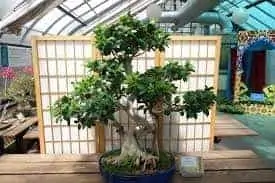
Unlike what many think, more bonsai trees thrive outdoors rather than in, due to the much availability of sunlight. Unfortunately, having mostly outdoor trees means that in colder climates, there are not that many species to grow except for the ficus tree.
Which in my opinion is one of the best indoor/outdoor species to get as a beginner because it does so well in most climates (both indoor and outdoor).
There are two types of Ficus that grow well indoors, the Ficus retusa and Ficus ginseng.
In the art of bonsai, it is very important to restrict the size of the plants so you need to select a small container.
Because ficus trees will do well in smaller containers. They’re also less demanding as a tree on its own,
not requiring constant care like watering for example. Ficus prefer sunny areas so you should always try to locate a sunny place to raise your ficus plant.
Chinese Elm
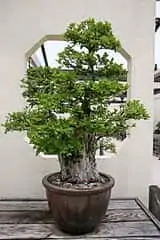
Chinese Elm is well known for its slow growth pace.
The Chinese elm tree is good for beginning bonsai artists. The Chinese elm is also a very undemanding tree to maintain. This is because of how easy it is to grow in most climatic conditions, both indoors and outdoors, and their resistance to pest infections. Because it has a slow rate of growth it makes the Chinese elm tree easy to prune and shape.
Note:
If you’re growing it indoors, always make sure to select a spot with lots of morning sun but not too much during the hot day.
Juniper
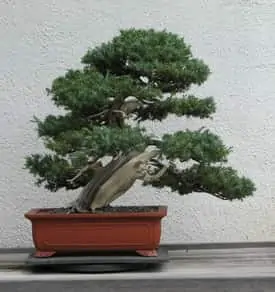
Also, one of the more pest-resistant trees on this list, the juniper, is a pretty needle-leaved tree that’s one of the most attractive in miniature form.
Junipers are susceptible to spider mites and webworms so, when you do frequent maintenance in the form of regular pruning it can help eliminate and prevent infestations,
Which will also help keep the leaves from getting too messy. Juniper is perfect for beginners because of how easily it can recover from over-pruning and other pruning mishaps. This will make it easier for beginners because they won’t have to worry about ruining the tree so much.
It should be noted though that, junipers mostly thrive outdoors they can also live indoors provided you take care of it. It’s advisable to place them in a spot where the tree can easily get 4 hours of sun daily.
Cotoneaster
One of the smallest tree species on the list, the Cotoneaster species are well suited to the art of bonsai. One of the features they are known for is they have glossy green leaves and some small apple-shaped fruits that appear after a bloom of little white flowers. Its size makes it really easy for most people, including beginners, to keep, and they’re both indoor and outdoor plants, provided it’s getting a lot of sunlight.
Portulacaria
Portulacaria are generally known as dwarf jade or baby jade, are excellent for beginners as they are very low maintenance species, they don’t require to be watered constantly. They’re a fast-growing species so careful and regular pruning is necessary to maintain an aesthetically pleasing tree.
Note:
Be careful that you don’t overwater as the Portulacaria species is very susceptible to root rot.
Rosemary
Ever thought of keeping edible bonsai trees? Rosemary is the way to go.
The best thing about the Rosemary plant is that after pruning, you won’t only be getting an aesthetically pleasing tree, but you’ll also be left with edible herbs you can use to add flavor to your dishes. Other examples of edible indoor bonsai plants you can keep are;
Thyme
Oregano
Laurel
Lavender
Bay Leaf
Note:
Frequent watering is important for rosemary plants to thrive well, but be careful not to do it too much as they’re also susceptible to root rot.
Other Indoor Bonsai Plants for Advanced
Japanese Maples
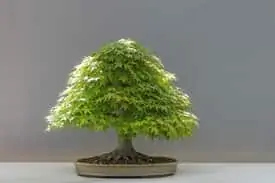
These are deciduous hardwood trees that are famous for their red or green leaves that turn a bright red, orange, or yellow in the fall. These plants are not very good plants for beginners because they require a lot of time and care, both for careful pruning and for watering daily.
Cedar
Cedars are mostly outdoor plants because They require lots of patience and care; so they are ideal for advanced and experienced growers.
There are four cedar species that are the best for bonsai;
Cedar of Lebanon,
Cyprus Cedar,
Himalayan Cedar, and
Atlas Cedar.
Baobab
Easily described as a tall and huge tree originating from the continent of Africa. The baobab is fairly easy to care for in warm climates, but they do not do well in cold and winter seasons. Baobab tree bonsai requires a lot more care during the cold of the winter zones.
Common Beech
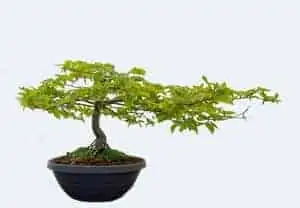
The common beech is a tree usually presented in the style of an upright plant. When properly taken care of, it is one of the most stunning bonsai you could keep, with their leaves turning golden yellow in autumn. You should know that the common beech is a very slow tree to grow, hence not the easiest plant to grow.
Conclusion
If you have a lot of patience and dedication to keep a bonsai tree, these may be your best options to choose from. It can be a really fun way to pass the time.
Recent Posts
Have you found yourself wondering, 'why is my bamboo growing so slow?' Despite the fact that bamboo plants are remarkably fast-growing, it can sometimes take months (or even years!) to see any signs...
Miracle-Gro is a huge help when you are trying to get decent yields out of your plants or if you want them to thrive. However, you may have noticed that a single dose of fertilizer does little to...
